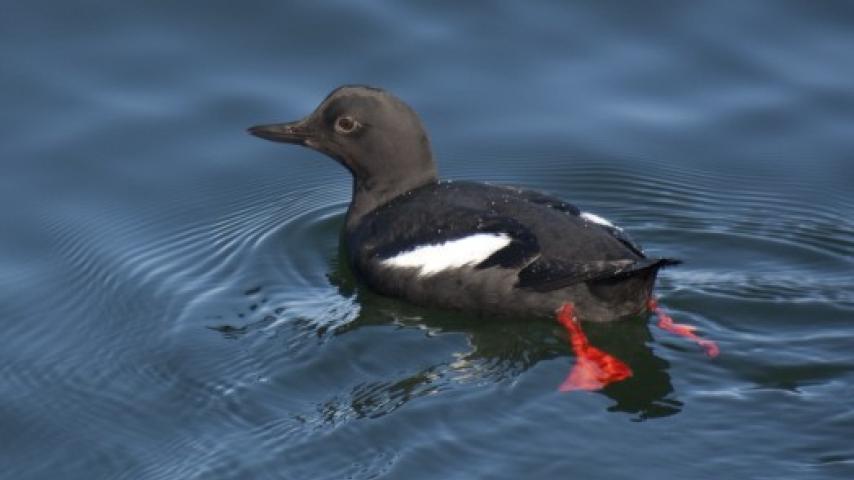Pigeon Guillemot (Cepphus columba)
Pigeon Guillemots are one of only a few species of seabirds that nest on the shores of Puget Sound. They are able to do this because they are crevice and burrow nesters, and the dark recesses of docks and piers are seen as adequate substitutes for natural crevices or burrows they themselves dig in vertical banks above the water.

KINGDOM Animalia - PHYLUM Chordata - CLASS Aves - ORDER Charadriiformes - FAMILY Alcidae
Guillemots in breeding plumage are spectacular, with black and white plumage and bright red-orange mouth and feet. When spring comes around and pairs begin courting, much use is made of those bright colors in displays both in the air and on the water. The birds constantly make high-pitched calls that add to the visual display.
In fall, the adult guillemots molt into a more subdued plumage, a mixture of black and white. They are variable, and some birds are largely white, the only local diving birds with so much white in their plumage. The big white wing patches and brightly colored mouth lining and feet can be seen throughout the year. Juveniles are usually darker, with fewer white markings and smaller wing patches.
Guillemots are fish eaters like many of their relatives (murres, puffins, murrelets) among the alcids. But while the other fish-eating alcids ply the surface and subsurface waters after the big schools of silvery herring and sand lance, guillemots are specialists in bottom fishes. They are all wing-propelled divers, literally flying below the water surface with rapidly beating wings. The feet are used only as rudders, if that. Guillemots, however, propel themselves to the bottom and then move slowly over it with the help of paddling feet as well as wing strokes.
The wings of alcids are relatively small, to give them more propelling power beneath the surface, so when they fly they have to beat them very rapidly to stay aloft. An alcid attempting a midair turn is likely to slide sideways for a while before completing its direction change.
Most alcids feed out at sea, and the lengthy flights they must make to find their wandering fish schools make it impossible to raise more than one young. Guillemots, however, feed much closer to shore and thus can manage to bring back enough fish to raise two young in their protected nests. Among the many kinds of fish they capture, bottom-living sculpins and gunnels predominate. These fish are well camouflaged, so perhaps a swimming guillemot, big red feet moving through the water, is enough to scare them into moving.